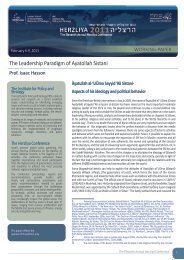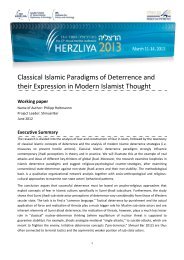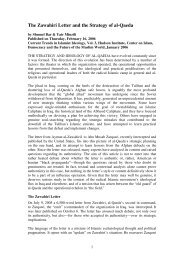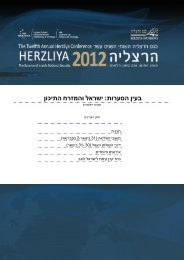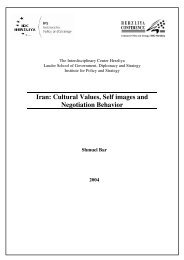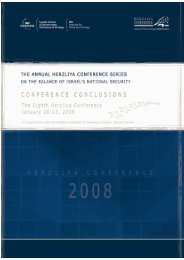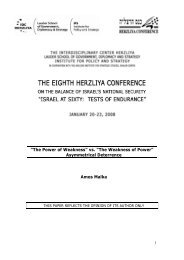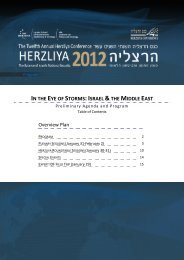Bashar's Syria: The Regime and its Strategic Worldview Shmuel Bar ...
Bashar's Syria: The Regime and its Strategic Worldview Shmuel Bar ...
Bashar's Syria: The Regime and its Strategic Worldview Shmuel Bar ...
Create successful ePaper yourself
Turn your PDF publications into a flip-book with our unique Google optimized e-Paper software.
Bashar’s <strong>Syria</strong> 393<strong>The</strong> Alawites<strong>The</strong> integration of the Alawite community (also known as Nusseiris) into modern <strong>Syria</strong>was not a foregone conclusion in the early days of the country. Ironically, it was Hafez al-Asad’s father, Suleiman al-Asad, who petitioned the French, along with five other Alawitenotables, to attach the Alawite territory to Lebanon <strong>and</strong> not to <strong>Syria</strong> because “. . . in <strong>Syria</strong>,the official religion of the state is Islam, <strong>and</strong> according to Islam, the Alawites are consideredinfidels . . . <strong>The</strong> spirit of hatred <strong>and</strong> fanaticism imbedded in the hearts of the Arab Muslimsagainst everything that is non-Muslim has been perpetually nurtured by the Islamic religion.<strong>The</strong>re is no hope that the situation will ever change. <strong>The</strong>refore, the abolition of the M<strong>and</strong>atewill expose the minorities in <strong>Syria</strong> to the dangers of death <strong>and</strong> annihilation, not to mentionthat it will annihilate the freedom of thought <strong>and</strong> belief.” 97Today, the Alawites are without doubt the main pillar of the <strong>Syria</strong>n regime, but they arenot the only one. References to an “Alawite regime” are simplistic <strong>and</strong> do not do justice tothe complex system of coalitions of interests that Hafez al-Asad built over the years. Thus,while the main political elite of <strong>Syria</strong> today is Alawite, not all elements of the Alawitecommunity have benefited from elite status. <strong>The</strong> Alawite community is composed of sixmajor tribes, 98 each one of which comprises a number of interrelated families. Foremostamong them, of course, is the al-Asad family <strong>its</strong>elf, which hails from the Kalabiyya tribein the city of Kardahah in Northern <strong>Syria</strong>. Naturally, the Kalabiyya tribe plays a centralrole in the regime, along with the Hadadin tribe, to which Bashar’s mother belongs, <strong>and</strong> theKhayatin tribe, which traditionally is allied with the Kalabiyya. 99<strong>The</strong> Alawites in general are prominent in the military <strong>and</strong> security apparatuses. Whilethey represent approximately 12 percent of the population, the Alawites hold almost 90percent of the top posts of the military <strong>and</strong> security. Even where Sunnis ostensibly are incontrol, they are augmented by Alawite deputies. <strong>The</strong> predominance of the Alawites in themilitary predates the present regime. It was due to the low social status of the Alawitesas domestic <strong>and</strong> menial labourers for the Sunni gentry of northern <strong>Syria</strong> that many of <strong>its</strong>sons sought social mobility in a military career. Consequently, the Alawites already playeda prominent role in the military regimes that ruled <strong>Syria</strong> before the “reform movement,”which brought Hafez al-Asad to the helm in 1970. It was, however, the Asad regime thatfinally cemented Alawite control of the Ba’th party <strong>and</strong> of the country.Though not all of the Alawite tribes play an equal role in the regime, the Alawiteregion in general has profited from preferential treatment. Once being the poorest areaof <strong>Syria</strong>, the Alawite region has become the richest <strong>and</strong> most modernized. <strong>The</strong> Alawiteshave become the economic <strong>and</strong> political elite. This prosperity to some extent has been atthe expense of the hitherto cultural <strong>and</strong> economic centres of northern <strong>Syria</strong>, particularlyHam’ah, Homs, <strong>and</strong> Aleppo, <strong>and</strong> generates resentment towards the Alawites, particularlyamong their immediate neighbors. 100 This resentment is said to impose a sense of solidarityon all parts of the Alawite community with the regime, out of fear that change may bringabout the fall of the Alawite predominance all together <strong>and</strong> precipitate revenge by the Sunnis<strong>and</strong> Isma’ilis. Furthermore, as a heterodox sect of Shi’ite Islam, which many Sunnis claimhas diverged so far from the tenets of orthodox Islam so as not be considered Muslim, 101the Alawite predominance in the regime has been <strong>its</strong> Achilles heel <strong>and</strong> a justification, inthe eyes of the Islamist movements, to rise up against it. This became particularly evidentduring the uprising of the Muslim Brotherhood in northern <strong>Syria</strong> (1976–1981), which wasfuelled by the claim that the regime was ruled by “heretics.”But is there an “Alawite leadership” separate to that of the regime? Observers of the<strong>Syria</strong>n regime mention a nebulous “Alawite Leadership” organized in a “National Council”



